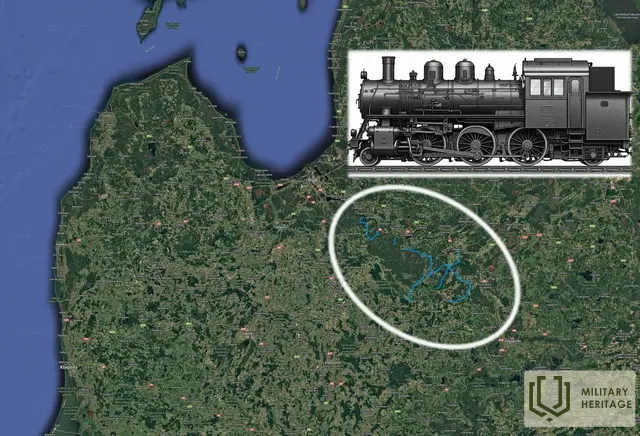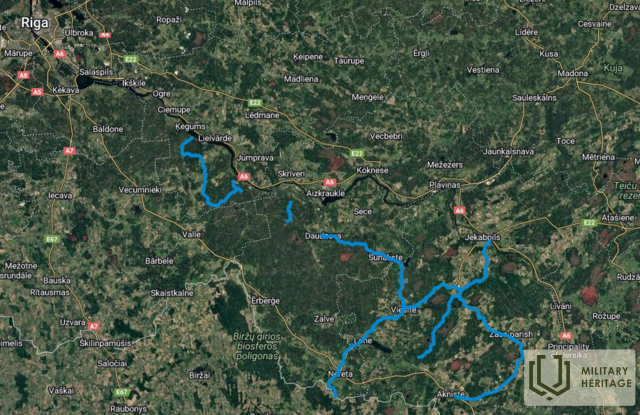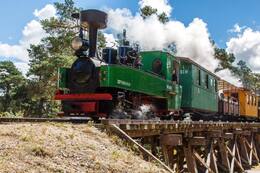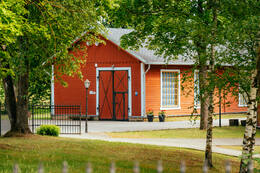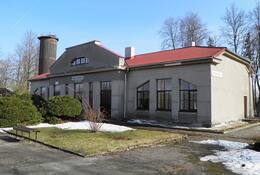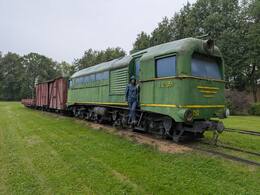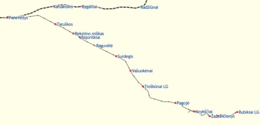600mm narrow gauge railways in Sēlia
It is often said that war is the father of all things, and that has literally been the case with the Latvian rural railways. Any army, whether attacking or defending, requires considerable resources to ensure warfare. When the German army entered the territory of Latvia in 1915, it faced supply challenges. By the end of 1915, the front had stabilized along the Daugava line. Historically, the population density in the territory of Sēlija was low, and therefore there was no extensive network of transport routes.
The First World War was also a time when railways played a major role in the redeployment and supply of troops, as road transport was not yet sufficiently developed, and horse-drawn vehicles were unable to provide sufficient speed and volume of cargo and people transportation. The Moscow-Ventspils broad-gauge railway line, which was put into operation in 1904, crossed Sēlija, and to a small extent the Daugavpils-Vilnius line. Tsarist Russia also practiced a strategy that envisaged limiting the expansion of the railway network in the western regions of the empire in order to hinder the enemy's advance in the event of war. Taking this into account, units were created in the great powers for the construction and operation of military railways. At the beginning of the war, the number of such specially trained military personnel in the German army reached 26,000. During their service, they were trained in specially equipped training grounds, where they had to build sections of track within a certain time, train accidents and damage to the tracks were also simulated, which they had to eliminate on their own. At the end of the training, an entire railway line had to be built in an unknown area within a few days, which had to be dismantled again after the training. As a result, the German army had access to well-prepared and trained specialists in the construction and operation of military railways.
During the war, military railway directorates (MED) were organized in the occupied territories. In the territory of Latvia and Lithuania, this was MED 8. Both railway construction and operation companies were under the control of such a directorate. The directorate was supervised by the Chief of Military Railways, who in 1918 already had more than 441,000 people at his disposal, of which only 40% were German military personnel.
The field railways themselves in Germany were divided into two groups – field railways (Feldbahn) and support railways (Forderbahn). Both had the same track gauge – 600mm, but their infrastructure elements differed. Field railways were more capitally designed, they were intended to operate with steam locomotives. In order for the steam not to give the enemy the approach of the train, support railways were built closer to the front, which were lighter, but on which smaller motor locomotives moved, horse traction was also widely used and in the immediate vicinity of the front, wagons were often pushed by hand. The rails were the lightest, which was allowed by the regulations – 9.5 kg/m for field railways and 4 kg/m for support railways. The track surface of the field railways was industrially produced in 5-meter long sections with iron sleepers. The weight of such a section was 220 kg, which made it movable by a team of several men. 2 m long sections were used in the support railways, which weighed 40 kg. This means that such tracks could be laid and prepared in a relatively short time. Field railways, on which steam locomotives ran, were intended to be built at a speed of 3-5 km per day (a week was allocated for the actual laying of the track for a 100 km section). Support railways could be built faster – even 6-10 km per day. The terrain was of great importance – field railways allowed for large gradients and radii, however, if overpasses and bridges had to be built, the work took longer.
The steam locomotives weighed 12 tons, while the diesel locomotives only 5 tons. They were powered by an internal combustion engine, which was not very powerful, but considering the recent appearance of the internal combustion engine, it proves that the German army was technically very modern.
It is possible that one of the support railway lines in the immediate vicinity of the front was built already at the end of 1915, but in Sēlija, the first field railway line for steam traction was the Skapišķi-Birži line, built in the spring of 1916. It was built relatively qualitatively and was already planned in advance for local traffic needs. This is also confirmed by the later operation of this railway in Latvia and Lithuania. However, the railways built in Sēlija were planned purely for military needs. It is not correct to believe that the Germans built these lines for the export of timber, although after the 1917 offensive, when the front moved much further east, they were used for this purpose, when the preparation of timber for the needs of the front was most likely replaced by its export to Germany. At the end of 1917, the status of the Sēlija narrow-gauge railway network was changed from field railways (Feldbahn) to small railways (Kleinbahn). Hence the name mazbānītis. Respectively, Feldbahn served the needs of the army, while Kleinbahn was for civilian traffic. It is also known that in 1918 the Germans began to organize the transportation of civilians along the Sēlija narrow-gauge railway network. They also demolished certain sections after the front moved forward, for example, the Ābeļi-Kaldabruņa railway is no longer shown on the maps of October 1918 and there is no information about its use. Such was the nature of the quickly built army narrow-gauge railways. The fact that most of this network remained in the territory of Latvia after the end of the First World War is more a coincidence of circumstances and Germany's defeat in the war with the subsequent proclamation of the state of Latvia.
In total, there are 5 rural railway lines in Sēlia:
Skapišķi-Jēkabpils line. This 110km long line can be considered the primary railway network of the Sēlija Karalauks, and Viesīte station - the most important railway junction. The line began in Lithuania at the Panevezys - Daugavpils broad gauge railway and crossed Latvia at Nereta;
Viesītes-Daudzevas-Seces line. Traffic on the line was opened on June 14, 1916. The line connected the Viesītes railway junction with the Maskava-Ventspils broad gauge line, connecting it to Daudzevas and continuing further to Seces. This connection actually also connected the Daugavpils-Paņevežas and Masakvas-Ventspils broad gauge lines, relieving the load on the Jelgava-Daudzevas broad gauge railway. The first station on this line, Baznīckrogs, served only for train change operations. The second station, Vilciņi near Piksteres Lake, was not intended for either freight operations or the transportation of people - it connected here with a light support railway branch, which ended near the front line in an uninhabited area - today's Rožu purva swamp at the End of the World. This line has preserved accurate information about another support railway branch - the railway enthusiast Imants Dreimanis in the 60s-70s. In the 1920s, he investigated that a dirt road had been built from Daudzeva II station to the Silnieki forester's house and further to Pagrabkalnie, along which movement took place by horse-drawn carriages, and along this 12km-long road, the Germans maintained traffic with warehouses at Jorgelani and Silnieki, as well as brought in timber. Another interesting moment is the 200-meter-long wooden structure overpass built in Viesīte itself. To save time and materials, the Germans did not build embankments where it would have been necessary, but instead arranged the lines on low wooden overpasses. Since wood impregnation technologies had not been discovered at that time, such overpasses and bridge structures ceased to serve in the first half of the 1920s and had to be replaced.
Rokišķi-Zasas-Siliņi line. The line began in Lithuania at the Daugavpils-Paņevežas broad gauge railway, entering Latvian territory near Aknīste and continuing to Geidāni and Zasa, where the support railway line towards the front began. Presumably, the purpose of this line was to improve supplies in the Jēkabpils and Dviete areas. Of particular note on this line is the impressive 15-meter-high wooden bridge over the South Sūsēja at Aknīste, which consisted of two sections and is often seen in pictures related to field-gauge railways during the war. After the war, it was no longer used.
Lines in the Eglaine area. As the front line at Dviete and Ilūkste bent away from the Daugava and went inland, there was a need for more intensive supply. The Daugava was no longer a natural obstacle here and both sides had wider opportunities for maneuver. Eglaine (Jelovka) station was located on the Daugavpils-Paņevežas broad-gauge railway and was chosen as the main node for the narrow-gauge network in this area. Both rural railway lines and support railway lines departed from this station. Extensive transshipment operations also took place here. A separate station was built next to the broad-gauge station to service the narrow-gauge railways. The broad-gauge railway could be safely crossed here, as further broad-gauge railway movement in the direction of Daugavpils no longer took place. Two rural railway lines departed from Eglaine – Eglaine-Visagina (to the south) and Eglaine-Bebrene (to the north). The line from Eglaine to Visaginas (Čornij Brod) was built thoroughly, using embankments instead of wooden trestles. Commercial train traffic was also provided from Visaginas to Zarasai on June 1, 1916. The regular arrangement of stations every few kilometers suggests that this line was used intensively. The line was also important during the War of Independence, when supplies of military equipment were even provided from Poland. After 1920, the line was discontinued. The other line – Eglaine-Bebrene – was used for only a year longer. It is believed that the reason for the closure was the many temporary wooden structural elements – trestles, which were widely used on these lines due to the marshy terrain and had served their time. Another reason may be the low demand for the relatively slow journey.
Obeli-Bebrene-Dviete line. The line began in Lithuania from the Daugavpils-Paņevežas broad-gauge railway, entered Latvian territory at Subate, continued to Kaldabruņa, then Bebrene and further to the front line near Dviete. Construction took place in January 1917. Such a period was chosen for construction, probably to make it easier to secure wooden trestles in the frozen swamp, which would be more difficult in warm weather. After the war, the sections of the line from Obeli to Kaldabruņa and from Bebrene to Dviete were no longer used, but the Kaldabruņa-Bebrene section was operated for a long time.
In addition to these main lines, there were a few separate shorter lines and several light support railway lines for horse traction, sometimes running parallel to the field railway lines, where steam traction locomotives ran.
A large part of the narrow gauge lines continued to be operated after the First World War, being completely closed only in 1971-1972. During the interwar period, the track network was liquidated in economically unviable places, but in places it was also expanded and additional lines were built. In 1919, the German army railway in Jēkabpils was extended by 7 km to reach the banks of the Daugava. This line was used to transport trees for floating on the Daugava. In turn, for example, Eglaine station (the term station refers not only to the station, building, but also to the track surface, adjacent territory, auxiliary buildings), which was one of the largest on the front and where both cargo exchange and rolling stock repair were provided, was no longer used after the war and was completely liquidated in 1927. The construction of the railway provided work for workers, but the railway itself was an important transport artery for logging, transporting both prepared materials and workers. In the 1930s, the 600mm railways in Sēlija were organized in such a way as to ensure the widest possible accessibility for local residents, but freight operations were maintained at the largest centers and terminal stations. Traffic in the region was provided by three lines – Viesīte-Daudzeva, Nereta-Jēkabpils and Aknīste-Siliņi. The Viesīte-Daudzeva line gave passengers the opportunity to transfer to the broad-gauge railway. Since only on certain sections of the lines trains ran every day (Jēkabpils-Daudzeva, Viesīte-Daudzeva and Jēkabpils-Aknīste), but on other sections only on certain days of the week, starting in 1936. The Latvian Railways Board also provided bus traffic, which was with daily regularity. The advantage of buses was their higher speed, so after the arrival of buses in the region, the main role of the railway remained the transportation of local agricultural products. However, passengers continued to travel by rail. In the winter of 1938, even bus traffic temporarily stopped due to the dusty roads, and the railway remained the only means of transport. Built for wartime needs and the corresponding regulations, the 600mm railway was slow. Passenger complaints persist that the 60km section from Jēkabpils to Nereta took 8.5 hours to travel, which means an average speed of 7 km/h, and in addition, there was a need to make a transfer. Of the total number of passengers, only 10% transferred to broad-gauge trains at the final stations, while the rest used the 600mm railway for movement within the region. In the second half of the 1930s, a significant decline in the number of passengers transported was observed, passengers preferred buses. After World War II, transport resumed. In parallel, bus traffic also continued to develop, but the narrow-gauge railway did not lack passengers, maintaining an important role in the mobility of the local population. In the late 1950s, rail transport reached its highest levels, unable to even cover all demand. Unlike the 1930s, when local residents mostly used the railway to transport agricultural products to the market and purchased products back home (essentially individual trade), after World War II the railway enabled forest workers to get to their workplaces and students to educational institutions, its importance was determined by the planned economy and ensuring the operation of collective farms. Returning to the 1930s, an interesting fact is that markets in the region were often organized near the railway station to facilitate the movement of goods. It was also possible to transport livestock from several stations, requesting wagons in advance. Analyzing cargo transportation by groups, in the 1920s and 1930s, the largest group was made up of timber and firewood, building materials, cereals, artificial fertilizers and livestock. An important role was also played by household goods, which made up a smaller percentage, but were integrally important for economic and everyday life. During the Soviet years, bases for handling timber were established at stations, the largest of which was near Daudzeva and in 1958. more than 150 employees worked there. From 1932. A sugar factory began operating in Krustpils and sugar beet transportation became another important category of goods, which the 600mm railway served until its closure.
The locomotive depot operated in Viesīte, which was one of the few electrified places. Most stations and stops did not yet have electricity connections in the interwar period. Communication equipment was also very modest, initially there were only three semaphores for the entire railway network.
As for rolling stock, the main type of rolling traction became steam locomotives equipped with four pairs of driving wheels, which were called brigade locomotives (Brigadelokomotive). Steam locomotives with three or two pairs of driving wheels were also used. Steam locomotives were the so-called tank locomotives, whose tanks (lighthouses) had space for a water reserve. They were also equipped with ejectors that could replenish water from water bodies or wells. Light-duty constructions were used on support railways by the company "Deutz" with two pairs of wheels (Forderbarhnen), and in some places "Oberursel" three-axle motor locomotives also appear in photographs. Such locomotives were equipped with an internal combustion engine and used kerosene as fuel. Taking into account their value, the German army withdrew all motor locomotives from the territory of Latvia. The most common of the wagons were brigade wagons (Brigadenwagen) with a carrying capacity of 5 tons. They were open-type four-axle gondolas, which had two two-axle bogies equipped with a hand brake. The use of the wagons was universal - they transported people, weapons, cargo, ammunition. Sometimes only two bogies were used to transport timber, which contained a wooden load between them. Such a solution was considered sufficiently safe for the specified operating conditions. Steam locomotives were manufactured from 1905 to 1919 in German factories Henschel, Borsig, Jung, Krauss, Orenstein & Koppel and others. It is known that after the First World War Latvia continued to operate 70 such locomotives, including other regions. In turn, the wagons were manufactured from 1894 to 1917 in various enterprises. After the war, a large part of them were rebuilt from gondolas into closed wagons for the transportation of passengers and cargo. German army wagons were used for passenger transport until 1962, and for freight transport until 1972. Lighter 2.5t four-axle wagons were used for horse-drawn sections, as well as various wagons called artillery supply railway wagons (Artielerie-Folderbahnwagen). Simpler constructions were also used.
Track sets were manufactured according to a certain standard mainly in the factories of the Krupp company in Germany. The track gauge was 70mm. Track sections were produced both straight and with radii of 30m and 60m. The rails and sleepers served a long time – on some rural-gauge railways, track material left by the German army was used throughout their operation. In 1946, the Latvian Railway Road Service report noted that the original rails on iron sleepers were still used on 93.9% of all 600mm railways in operation, but on the Viesīte railway network this figure was 99%.
After the closure of the narrow gauge railways, almost all the metal parts of the locomotives and wagons were scrapped, and the tracks were dismantled. Some locomotives and wagons ended up in museums. The last small-scale railways ceased operations in 1973, a few years after the official closure. Quite simple trains were used to dismantle the track - the railway demolished itself.
One of the proofs of the strong roots of the narrow-gauge railway in the culture and socio-economic processes of the region is the Railwaymen's Day, celebrated in early August at the Viesīte Museum "Sēlija", where people gather in the flower-decorated locomotive depot, even though trains have not stopped here for more than 50 years.
Today, the evidence of the narrow-gauge railway in the region may not be obvious to the uninitiated, but they are numerous and can still be found. In places, the embankments of the lines have survived, as well as trenches where they crossed lower places. From Eglaine station in the direction of Ilūkste, there is even a supporting railway embankment that is two horses wide and where the wagons were pulled by horses. In Pilskalnes Siguldinė, parts of the railway line have been turned into walking paths. Station buildings have survived, which in some places have been converted into residential buildings, in others abandoned, and goods barns. The names of the stations are still visible in some of the station and stop buildings. The Vārnavas station complex is the best preserved to this day. The Sēlija Museum is located in the Viesīte railway junction – it includes a brick locomotive depot built in 1927 and a wooden carriage workshop built in 1934. The preserved steam locomotive Ml-635, a closed freight wagon and platform, as well as a motorized trolleybus with a trulli and a service wagon can also be viewed here. The Mazbānītis can be seen in action at the Ventspils Seaside Open-Air Museum, where two operational lines of 1.4km and 3km in length have been created from sections of the original track.
600mm railway in Sēlija during World War I, I.Freiberga, T.Altbergs, K.Dambītis, A.Markots, Society “Sēlijas kultūrs projekti”, 2022;
Military Railways in Latvia 1915-1920, T.Altbergs, K.Dambītis, Ē.Jēkabsons, B.Lielkāja, Society “Sēlijas kultūras projekti”, 2024;
Rural railways, T.Altbergs, A.Biedriņš, D.Punculs, A.Tukišs, Ventspils Museum, 2019
Related timeline
Related topics
Related objects
Narrow gauge railway train “Mazbānītis” in Ventspils Seaside Open-air museum
In the Seaside Open-Air Museum in Ventspils you can take a ride on two narrow-gauge railway lines with the train ‘Mazbānītis’. The Circle line is 1.4 km and the Mountain line is 3 km. ‘Mazbānītis’ is the locomotive that transported passengers and cargo on 600 mm narrow-gauge railway tracks between 1916 and 1963. It is a legacy of military history from World War I that once played an important role in the cultural and economic development of northern Kurzeme by connecting settlements and providing new jobs.
Construction of a large 600 mm narrow-gauge railway network is largely associated with World War I, when the German Army in 1916 started the construction of several so-called military field railways (Heeresfeldbahn in German) in the occupied territory of Latvia. These railways could be quickly constructed, deconstructed and moved to another front line. The Latvian narrow-gauge railway network was used also during World War II. For almost 60 years the narrow-gauge railway was the only safe way of transporting passengers, various agricultural products and timber to cities in both winter and summer.
“Sēlija” Museum in Viesīte
“Sēlija” museum in Viesīte contains several parts: Sēlija House (Sēlija cultural history exhibition) and Tourist Information Point (located in the former railway office building), the former Locomotive Repair Workshop of Viesīte Depot, Crafts Centre and Sēlija narrow-gauge railway history exhibition (located in the Locomotive Repair Workshop building). The most recognisable part of the Museum in Viesīte is the Little Train Park, which is located on the grounds of the former Viesīte Depot.
The narrow-gauge railway was originally built by the German Army from 1915–1916 to transport military cargo, but, after World War I, it was adapted for passenger transport. The museum displays a steam locomotive manufactured by the Schwarzkopff company in 1918, as well as a service cart built in 1916, a freight cart, a timber transport platform, a horsecar, a trolley, and an exhibition on the Sēlija railway. The museum also manages seven historical buildings of the station. The “Mazā Bānīša Parks” (Little Train Park) is friendly for visitors with children.
Not far from the Little Train Park – in the historical Viesīte Station Square – visitors can see the only narrow-gauge railway section in Latvia with a water pump that has been preserved. Several historic buildings are located near the station square: a railway freight warehouse, a cultural centre, a passenger station building and a dispensary.
Vecumnieki Railway Station
Vecumnieki railway station is located south of the village of Vecumnieki.
Vecumnieki railway station was built in 1904 as a station on the Ventspils-Moscow railway line. Initially, it was called “Neugut” (during the German occupation in 1916/1917, it was called “Neugut Kurland”). It gained greater importance during the First World War, when a European-wide railway branch was built from it. In 1916, when the German army's front line had strengthened and stabilized along the left bank of the Daugava, on March 15, a decision was made to build a 25 km railway line with a track gauge of 1435 mm from Vecumnieki to Baldone (station: Mercendarbe - Merzendorf) for the needs of supplying the front. On March 30, about 5,000 workers began work, and by May 1, the line had been built to Skarbe station, and by May 6, to Mercendarbe. The sequence of stations from south to north was as follows: Neugut Kurland, Nougut Nord, Birsemnek, Gedeng, Skarbe, Merzendorf. At the largest of the stations, Skarbe, cargo was transshipped, from where it was transported to the front by horse-drawn transport. This railway existed for only a few years, as late as 1921, logs and firewood were transported along the railway line, until it was demolished in 1925. The location of the railway line is very different in different sections - in places it is crossed by roads of various importance, in places, as the embankment is clearly visible, it crosses forest massifs. There are places that are difficult to pass during the vegetation period.
At the former Gediņi station ("Bahnhoff Gedeng"), a narrow-gauge railway branched off in a northeasterly direction, the tracks of which continued towards the Daugava. At the Sila house it crossed Silupi (Kausupi) (former station "Bhf. Sille"), but at the Podnieki house it branched off. The first branch went to the right to Berkavas, and the second to the left to Vilki mountains and then returned to the broad-gauge (1435 mm) railway at the Skarbe station.
In September 1917, the Germans built another narrow-gauge railway line (gauge of 600 mm) from Mercendarbe and Skarbe to the Daugava, where they built a pontoon bridge and opened traffic all the way to Ikšķile on October 1. The flood of December 4 washed away the aforementioned bridge.
Since 1919, the station has been called Vecmuiža. In 1926, a stone building (architect J. Neijs) was built on the site of the wooden station building destroyed in the war. In 1940, the station was renamed Vecumnieki. On June 14, 1941 and March 25, 1949, several hundred Latvian residents were deported from Vecumnieki station, as well as from many other Latvian railway stations. In total, 44,271 Latvian residents suffered as a result of the deportation actions of March 25, 1949 (until March 30).
In 2000, passenger train traffic was closed on the Jelgava-Krustpils line; currently, this line is used only for freight train traffic.
Narrow gauge railway in Biržai
A 20th-century narrow-gauge railway complex with significant historical, architectural and scenic value.
"Siaurukas" is a 750 mm (2 ft 5 1/2 in) narrow gauge railway, the longest in Europe and one of the most unique heritage sites in Lithuania, therefore the surviving sections of the narrow gauge railway are protected as cultural property. Lithuania has 158.8 km (110 mi) of 750 mm (2 ft 5 1/2 in) narrow gauge railway lines, although only 68.4 km (serving five stations) are in regular use, with 12 locomotives operating. They are included in the Lithuanian Register of Immovable Cultural Heritage Sites.
The narrow-gauge railway line reached Biržai in 1921–1922, when the Biržai–Gubernija railway section was extended. This was the first narrow-gauge railway section built at the expense of the Lithuanian state itself.
In the year of independent Lithuania, 467 km of narrow-gauge railway was built. Forest materials for export, quartz sand, livestock, flax, beets, food supplies were transported along it. Adults went to work by train, and children - to school. On weekends, the train was full of berry and mushroom pickers, and in winter - skiers. Until the terminus of the Guberniya line in the city of Šiauliai, the train stopped at 16 railway stations.
In 1922, a passenger had to pay 7.20 Lithuanian auksinas (German Ostmarks) for one kilometer traveled in a 1st class carriage, and 1.80 Lithuanian auksinas for a 3rd class carriage.
During World War II, the narrow-gauge railway was militarized. It was also used to transport "enemies of the state" - people whom the Soviet authorities considered disloyal (even without any particular reason) - in simple cattle cars for forced deportation to Siberia. After the war, the prospects for the restoration and development of the narrow-gauge railway became very uncertain. The future of the Lithuanian railway was determined by the goals of the Soviet economy and politics.
From 1945 to 1980, more than 400 km of 20 narrow-gauge railway sections were closed. The longest remained the Biržai - Joniškeli and Joniškeli - Panevezys sections, which had a slightly higher freight turnover. 3 trains arrived at Biržai: 2 freight and 1 passenger train. With the expansion and development of road transport, the narrow-gauge railway became economically unstable. In 1988, passenger transport was discontinued. In 1996, during the Independent Republic of Lithuania, the narrow-gauge railway line to Biržai was completely closed.
Today, the narrow-gauge railway complex consists of the depot and station buildings, a water tower, and the old railway section. Later, as a testament to its glorious days, a recently repainted locomotive was brought for viewing.
Aukštaitija barge railway
The Aukštaitija Narrow Gauge Railway (Lithuanian: Aukštaitijos siaurasis geležinkelis) is a 68.4-kilometre (42.5 mi) long tourist railway in Lithuania, running from Panevėžys to Rubikiai, with a track gauge of 750 mm (2 ft 5+1⁄2 in).
The narrow-gauge railway was built from 1891 with a track gauge of 750 mm (2 ft 5+1⁄2 in). The first section was completed on 11 November 1895 from Švenčionėli to Pastovi, and in 1898 it was extended to Panevėžys. Regular passenger and freight traffic began in the autumn of 1899. Initially, there were 2 depots, 14 stations, 15 locomotives, 58 passenger carriages of various types, 6 mail carriages, as well as 112 closed and 154 open freight carriages. In 1903, approximately 65,000 tons of freight and 40,632 passengers were transported.
Panevėžys became a regional center during the period of Lithuanian independence (1920–1938), and therefore many raw materials such as coal, oil, sand, salt and fertilizer were transported, as well as agricultural products such as flax, lard, sugar, grain, flour and timber.
During World War I, the German army built two field railway extensions with a 600 mm (1 ft 11+5⁄8 in) gauge in 1916, from Gubernija to Pasvalija and from Joniškis to Žeimeļi. The railway was functionally important between World War I and World War II and contributed to the economic development of the region. After World War II, it was operated by the state-owned company "Lietuvos Geležinkeliai".
Traffic began to decline in the second half of the 20th century. In 1996, the railway line north of Panevėžys was closed. In the same year, the narrow-gauge railway was included in the List of Immovable Cultural Properties of the Republic of Lithuania and acquired the status of a cultural heritage site. Tourist trains then began to operate. Freight traffic was gradually discontinued in 1999. On 1 November 1999, a new Narrow-Gauge Railway Department was established within the state railway company "Lietuvos Geležinkeliai". However, passenger traffic was temporarily suspended in 2001. Since 2006, tourist trains have been pulled by TU2 diesel locomotives, and they have been well received with increasing passenger numbers.
Daudzeva - Sunākstes - Viesītes narrow gauge railway
Viesīte narrow-gauge railway junction – a strategically important railway network in Sēlia
The Viesīte narrow-gauge railway junction was the largest railway network of its kind (600 mm gauge) in Latvia. It operated from 1916 to 1972 and connected several important towns and villages of Sēlija – Nereta, Viesīte, Daudzevu, Jēkabpils, Aknīsti and others. The maximum length of the railway reached 280 kilometers.
Origin and military significance
This railway was built during the First World War – from 1915 to 1916 – along the banks of the Daugava River to ensure the supply of the front and the movement of troops. It was built by the German army with the help of the local population. This was the so-called “castle railway”, which was used for military purposes.
Several lines were built in 1916:
- Skapiški (Lithuania) – Viesīte – Aldaune (100 km),
- Pasmalve – Eglaine – Siliņi (120 km), where this line connected to the previous one,
- Rokiški – Aknīste – Geidāni (50 km),
- Ābeļi – Subate – Kaldabruņa (30 km), where there was a railway triangle for turning trains.
Branches to Bebrene, Dvieti, Zasa and Vandāni were also built. Some of these lines were dismantled in 1920–1927.
In the same year, 1916, the Viesīte–Daudzeva line was also built, with a branch to Sece.
After the war – civil traffic and development
After World War I, some of the lines were demolished, but the rest were incorporated into the Latvian State Railways network. They continued to be used for both freight and passenger transport.
Several lines operated during the interwar period:
- Jekabpils–Nereta,
- Siliņi–Aknīste,
- Guest–Daudzeva,
- Siliņi–Elkšņi (31 km, built in 1932 for forestry work).
In 1936, a vocational school was opened in Viesīte, where railway specialists were trained. In the mid-1930s, 67 passenger carriages, service motorized trolleybuses, snowplows, and Ml series steam locomotives operated at the Viesīte railway junction.




